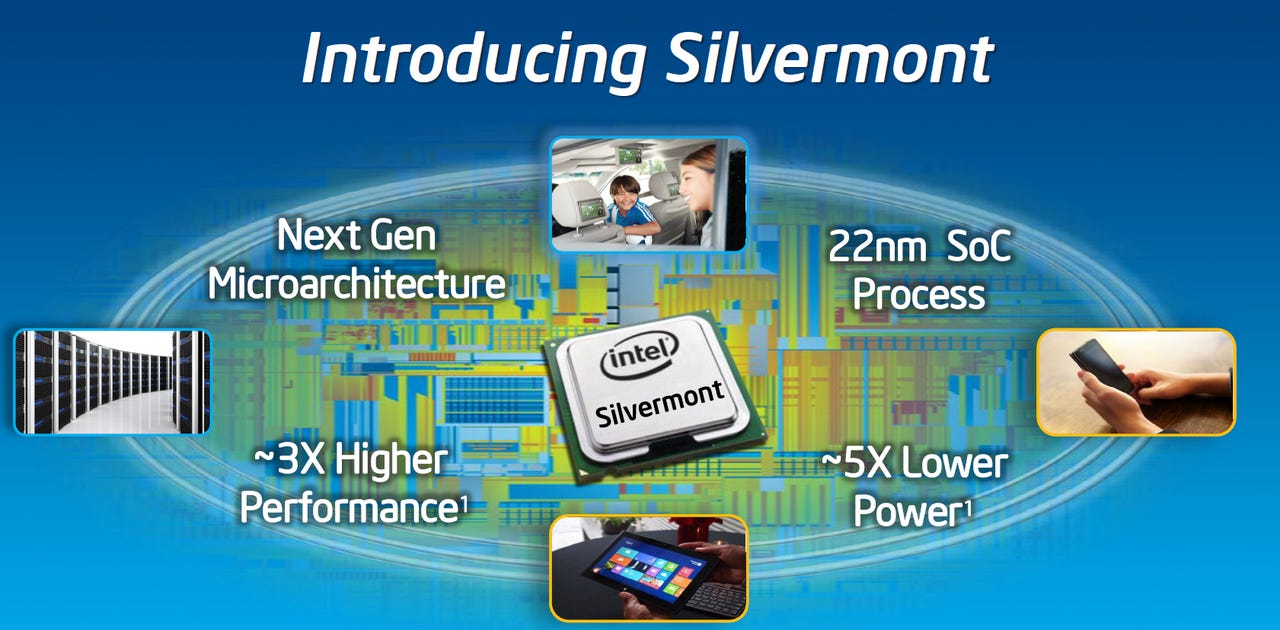Silvermont: Intel's silver bullet for mobile?


More than five years after Intel first announced Atom, the company has introduced the first top-to-bottom redesign of its low-power processor. The new Silvermont microarchitecture is designed for everything from tiny embedded devices to micro-servers, but Silvermont’s real target is clear: smartphones and tablets. Does Intel finally have all the ingredients to challenge ARM in mobile?
There is little doubt Intel has superior manufacturing technology. It is manufacturing processors with features as small as 22 nanometers while competitors rely on contract manufacturers, or foundries, that are currently using a 28nm process. Furthermore Intel has already shipped more than 100 million chips using 3D transistors, known as FinFETs. The rest of the industry won’t start cranking out chips with FinFETs until the end of 2014--three years after Intel started production. All other things being equal, better process technology results in chips that are faster, use less power and are cheaper to make. Intel aims to use this advantage to work its way into tablets and smartphones by speeding up the Atom roadmap with 22nm Silvermont this year followed by 14nm Airmont next year.
Great manufacturing helps, but you also need a competitive chip design. The current Atoms are based on the 32nm Saltwell microarchitecture, a derivative of the original 45nm Bonnell processors. Silvermont, however, is an entirely new design. Like the Core and Xeon processors, it uses out-of-order execution to speed up operation. The multi-core architecture and system fabric is based on up to four modules, each of which has two CPU cores and 1MB of shared cache. Interestingly Silvermont SoCs do not use Hyper-Threading--an acknowledgement that the number of physical cores has become a selling point in smartphones and tablets. Silvermont also supports new instructions and has better power management features.
The combination of better process technology and a new microarchitecture delivers three times more peak performance and five times lower power than the current Atom Z2580 (Cloverview), a 32nm Saltwell SoC with two cores and four threads running at up to 2.0GHz, according to Intel. The company also showed data comparing a Silvermont favorably (of course) to unnamed ARM-based dual- and quad-core chips for smartphones and tablets. One of the new features of Silvermont is the ability to dynamically share power not only among the CPU cores, but also between the CPU and graphics, depending on the workload. Silvermont SoCs can support a wide range of performance and power levels, which Intel says is a better solution than mixing and matching different types of cores like ARM’s big.LITTLE architecture or Nvidia’s fifth “battery-saver” core.
Until we actually see devices using Silvermont SoCs, it’s impossible to say how it will really stack up to ARM. The first ones, part of the Bay Trail platform, should be available in Windows 8 and Android tablets in time for the holidays. Intel said Bay Trail will also be used in entry-level laptops and desktops with “innovative form factors,” which primarily means less pricey convertibles. The Merrifield platform will be in production by the end of the year, but won’t show up in Android smartphones until the first half of 2014. The Silvermont microarchitecture will also be used in Avoton chips for micro-servers; Rangeley for routers, switches and security appliances; and an unannounced embedded processor for entertainment devices, perhaps including the set-top box for Intel’s upcoming TV service.
Even if Silvermont matches ARM on performance and power, it may not be enough. Smartphones will continue to be a tough sell. Last year ARM cores were used in 2.2 billion chips in smartphones (each handset contains multiple chips with ARM cores)--good for around 90 percent market share. Smartphone companies rely on the extensive ARM ecosystem and support to help them design products and launch them quickly. Apple and Samsung use their own chips, and others are used to working with ARM customers such as Qualcomm, MediaTek and Spreadtrum, so it will be tough for Intel to break in, especially without an integrated cellular baseband.
Tablets are more promising because that market is still in flux with new hardware and platforms emerging. Smaller, less expensive Android tablets are chipping away at the iPad’s market share. Windows 8 and Windows RT are off to a slow start in tablets, but Microsoft says the Windows Blue update will enable tablets and convertibles in a broader range of sizes and prices. Asus CEO Jerry Shen told The Wall Street Journal last week that he’s “very optimistic” about smaller Windows 8 tablets with prices as low as $300 available later this year. In tablets, Intel will have to contend not only with ARM quad-cores but also with AMD’s Temash APU, which is already in production. Still this might be the year Intel finally makes up some ground in tablets with Bay Trail.
The good news is that by the holiday season, rather than choosing between an iPad or a low-cost Android tablets, there should be a lot more to choose from in terms of design, price and platform.